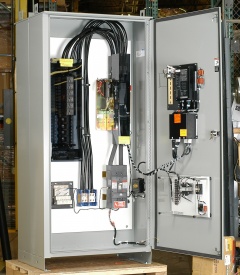Electrical Equipment
| Infobox on Electrical Equipment | |
|---|---|
| Example of Electrical Equipment |  |
| Facts | |
| Origin | - |
| Stowage factor (in m3/t) | - |
| Humidity / moisture | - |
| Ventilation | - |
| Risk factors | See text |
Electrical Equipment
Description / Application
Electrical equipment includes any machine powered by electricity. They usually consist of an enclosure, a variety of electrical components, and often a power switch. Examples of these include:
- Major appliance
- Microcontroller
- Power tool
- Small appliances
More specifically, often electrical equipment refers only to components part of the electrical distribution system such as:
- Electric switchboards
- Distribution boards
- Circuit breakers and disconnects
- Electricity meter
- Transformers
Shipment / Storage / Risk factors
Electrical equipment, radio, television, video, hi-fi equipment and the like are susceptible to shock, heavy handling in transit and impact damage. Particular note should be made of type of packing and suitability to withstand normal transit hazards.
Dependent upon size of unit, the use of heavy cardboard cartons is commonly employed with internal packing of formed polystyrene and plastic sheeting or open-ended bags.
The question of an acceptable form of repair can give rise to problems, particularly when manufacturers’ warranties or guarantees have to be maintained. Wherever possible in new items, unless replacement components can be obtained, it is often more advantageous to agree a fair depreciation allowance with the importer, and for him to retain the equipment as spare parts, or sale on a depreciated basis without manufacturers’ guarantee. This refers to impact damage and extensive water damage.
In the event of water damage, immediate inspection and remedial action is of the utmost priority. If cartons show evidence of water or excess moisture, this does not necessarily indicate damage to contents, particularly when polystyrene and plastic open-ended bags are used for internal packing. Care should, however, be taken in ensuring a thorough check, with testing of apparatus if necessary, and if facilities are available.
Excess moisture on cartons can have serious concealed effects on electrical equipment. Units so affected should be removed from the packing without undue delay. Contents should be immediately examined for moisture contamination, cleaned as best possible and left for the natural drying-out process within the receiving premises. Dependent on the type of equipment, voltage factor etc., test operation under power may then follow.
One immediate check to determine extent of moisture contamination, where outer carton shows signs of wetting, and later drying, is to examine the binding pins in any enclosed instruction manual.
See also Household and Personal Effects.











